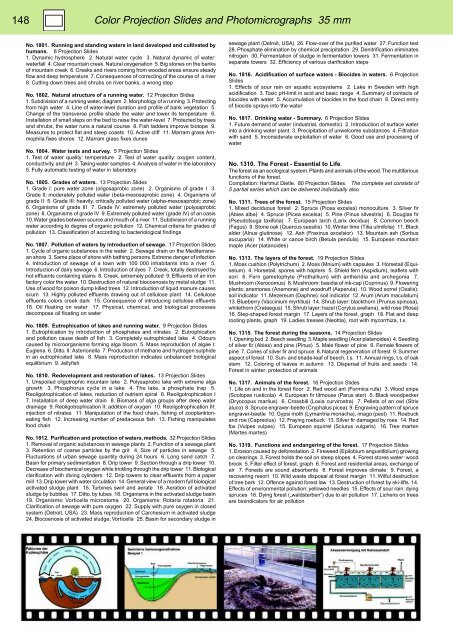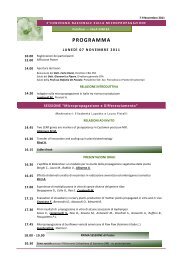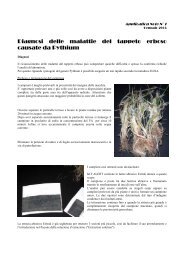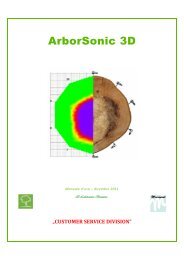BIOLOGY - microscopia.info
BIOLOGY - microscopia.info
BIOLOGY - microscopia.info
Create successful ePaper yourself
Turn your PDF publications into a flip-book with our unique Google optimized e-Paper software.
148<br />
Color Projection Slides and Photomicrographs 35 mm<br />
No. 1801. Running and standing waters in land developed and cultivated by<br />
humans. 8 Projection Slides<br />
1. Dynamic hydrosphere 2. Natural water cycle 3. Natural dynamic of water:<br />
waterfall 4. Clear mountain creek. Natural oxygenation 5. Big stones on the banks<br />
of mountain creek 6. Creeks and rivers coming from wooded areas ensure steady<br />
flow and deep temperature 7. Consequences of correcting of the course of a river<br />
8. Cutting down trees and shrubs on river banks, a wrong step<br />
No. 1802. Natural structure of a running water. 12 Projection Slides<br />
1. Subdivision of a running water, diagram 2. Morphology of a running 3. Protecting<br />
from high water 4. Line of water-level duration and profile of bank vegetation 5.<br />
Change of the transverse profile shade the water and lower its temperature 6.<br />
Installation of small steps on the bed to raise the water-level 7. Protected by trees<br />
and shrubs, the water runs a natural course 8. Fish ladders improve biotope 9.<br />
Measures to protect flat and steep coasts 10. Active cliff 11. Marram grass Ammophila<br />
fixes shores 12. Marram grass fixes dunes<br />
No. 1804. Water tests and survey. 5 Projection Slides<br />
1. Test of water quality: temperature 2. Test of water quality: oxygen content,<br />
conductivity, and pH 3. Taking water samples 4. Analysis of water in the laboratory<br />
5. Fully automatic testing of water in laboratory<br />
No. 1805. Grades of waters. 13 Projection Slides<br />
1. Grade I: pure water zone (oligosaprobic zone) 2. Organisms of grade I 3.<br />
Grade II: moderately polluted water (beta-mesosaprobic zone) 4. Organisms of<br />
grade II 5. Grade III: heavily, critically polluted water (alpha-mesosaprobic zone)<br />
6. Organisms of grade III 7. Grade IV: extremely polluted water (polysaprobic<br />
zone) 8. Organisms of grade IV 9. Extremely polluted water (grade IV) of an oasis<br />
10. Water grades between source and mouth of a river 11. Subdivision of a running<br />
water according to degree of organic pollution 12. Chemical criteria for grades of<br />
pollution 13. Classification of according to bacteriological findings<br />
No. 1807. Pollution of waters by introduction of sewage. 17 Projection Slides<br />
1. Cycle of organic substances in the water 2. Sewage drain on the Mediterranean<br />
shore 3. Same place of shore with bathing persons. Extreme danger of infection<br />
4. Introduction of sewage of a town with 100 000 inhabitants into a river 5.<br />
Introduction of dairy sewage 6. Introduction of dyes 7. Creek, totally destroyed by<br />
hot effluents containing stains 8. Creek, extremely polluted 9. Effluents of an iron<br />
factory color the water 10. Destruction of natural biocoenosis by metal sludge 11.<br />
Use of wood for poison dump killed trees 12. Introduction of liquid manure causes<br />
scum 13. Highly polluted effluents drawing out of cellulose plant 14. Cellulose<br />
effluents colors creek dark 15. Consequence of introducing cellulose effluents<br />
16. Oil floating on water 17. Physical, chemical, and biological processes<br />
decompose oil floating on water<br />
No. 1809. Eutrophication of lakes and running water. 9 Projection Slides<br />
1. Eutrophication by introduction of phosphates and nitrates 2. Eutrophication<br />
and pollution cause death of fish 3. Completely eutrophicated lake 4. Odours<br />
caused by microorganisms forming alga bloom 5. Mass reproduction of algae I:<br />
Euglena 6. Ditto. II: Asterionella 7. Production of methane and hydrogen sulphide<br />
in an eutrophicated lake 8. Mass reproduction indicates unbalanced biological<br />
equilibrium 9. Jellyfish<br />
No. 1810. Redevelopment and restoration of lakes. 13 Projection Slides<br />
1. Unspoiled oligotrophic mountain lake 2. Polysaprobic lake with extreme alga<br />
growth 3. Phosphorus cycle in a lake 4. The lake, a phosphate trap 5.<br />
Reoligotrophication of lakes, reduction of nutrient spiral 6. Reoligotrophication I<br />
7. Installation of deep water drain 8. Biomass of alga groups after deep water<br />
drainage 9. Reoligotrophication II: addition of oxygen 10. Reoligotrophication III:<br />
injection of nitrates 11. Manipulation of the food chain, fishing of zooplanktoneating<br />
fish 12. Increasing number of predaceous fish 13. Fishing manipulates<br />
food chain<br />
No. 1812. Purification and protection of waters, methods. 32 Projection Slides<br />
1. Removal of organic substances in sewage plants 2. Function of a sewage plant<br />
3. Retention of coarse particles by the grit 4. Size of particles in sewage 5.<br />
Fluctuations of urban sewage quantity during 24 hours 6. Long sand catch 7.<br />
Basin for primary sedimentation 8. Drip tower 9. Section through a drip tower 10.<br />
Decrease of biochemical oxygen while trickling through the drip tower 11. Biological<br />
clarification with diving cylinders 12. Drip towers to clear effluents from a paper<br />
mill 13. Drip tower with water circulation 14. General view of a modern full biological<br />
activated sludge plant 15. Turbines swirl and aerate 16. Aeration of activated<br />
sludge by bubbles 17. Ditto. by tubes 18. Organisms in the activated sludge basin<br />
19. Organisms: Vorticella microstoma 20. Organisms: Rotaria rotatoria 21.<br />
Clarification of sewage with pure oxygen 22. Supply with pure oxygen in closed<br />
system (Detroit, USA) 23. Mass reproduction of Carchesium in activated sludge<br />
24. Biocoenosis of activated sludge: Vorticella 25. Basin for secondary sludge in<br />
sewage plant (Detroit, USA) 26. Flow-over of the purified water 27. Function test<br />
28. Phosphate elimination by chemical precipitation 29. Denitrification eliminates<br />
nitrogen 30. Fermentation of sludge in fermentation towers 31. Fermentation in<br />
separate towers 32. Efficiency of various clarification steps<br />
No. 1816. Acidification of surface waters - Biocides in waters. 6 Projection<br />
Slides<br />
1. Effects of sour rain on aquatic ecosystems 2. Lake in Sweden with high<br />
acidification 3. Toxic pH-limit in acid and basic range 4. Summary of contacts of<br />
biocides with water 5. Accumulation of biocides in the food chain 6. Direct entry<br />
of biocide sprays into the water<br />
No. 1817. Drinking water - Summary. 6 Projection Slides<br />
1. Future demand of water (industrial, domestic) 2. Introduction of surface water<br />
into a drinking water plant 3. Precipitation of unwelcome substances 4. Filtration<br />
with sand 5. Inconsiderate exploitation of water 6. Good use and processing of<br />
water<br />
No. 1310. The Forest - Essential to Life.<br />
The forest as an ecological system. Plants and animals of the wood. The multifarious<br />
functions of the forest.<br />
Compilation: Hartmut Dietle. 80 Projection Slides. The complete set consists of<br />
5 partial series which can be delivered individually also.<br />
No. 1311. Trees of the forest. 15 Projection Slides<br />
1. Mixed deciduous forest 2. Spruce (Picea excelsa) monoculture 3. Silver fir<br />
(Abies alba) 4. Spruce (Picea excelsa) 5. Pine (Pinus silvestris) 6. Douglas fir<br />
(Pseudotsuga taxifolia) 7. European larch (Larix decidua) 8. Common beech<br />
(Fagus) 9. Stone oak (Quercus sessilis) 10. Winter lime (Tilia ulmifolia) 11. Black<br />
alder (Alnus glutinosa) 12. Ash (Fraxinus excelsior) 13. Mountain ash (Sorbus<br />
aucuparia) 14. White or canoe birch (Betula pendula) 15. European mountain<br />
maple (Acer platanoides)<br />
No. 1313. The layers of the forest. 19 Projection Slides<br />
1. Moss cushion (Polytrichum) 2. Moss (Mnium) with capsules 3. Horsetail (Equisetum)<br />
4. Horsetail, spores with hapters 5. Shield fern (Aspidium), leaflets with<br />
sori 6. Fern gametophyte (Prothallium) with antheridia and archegonia 7.<br />
Mushroom (Xerocomus) 8. Mushroom: basidia of ink-cap (Coprinus) 9. Flowering<br />
plants: anemones (Anemone) and woodruff (Asperula) 10. Wood sorrel (Oxalis):<br />
soil indicator 11. Mezereum (Daphne): soil indicator 12. Arum (Arum maculatum)<br />
13. Blueberry (Vaccinium myrtillus) 14. Shrub layer: blackthorn (Prunus spinosa),<br />
whitethorn (Crataegus) 15. Shrub layer: hazel (Corylus avellana), wild rose (Rosa)<br />
16. Step-shaped forest margin 17. Layers of the forest, graph 18. Flat and deep<br />
rooting plants, graph 19. Ladies tresses (Neottia), root with mycorrhiza, t.s.<br />
No. 1315. The forest during the seasons. 14 Projection Slides<br />
1. Opening bud 2. Beech seedling 3. Maple seedling (Acer platanoides) 4. Seedling<br />
of silver fir (Abies) and pine (Pinus) 5. Male flower of pine 6. Female flowers of<br />
pine 7. Cones of silver fir and spruce 8. Natural regeneration of forest 9. Summer<br />
aspect of forest 10. Sun- and shade-leaf of beech, t.s. 11. Annual rings, t.s. of oak<br />
stem 12. Coloring of leaves in autumn 13. Dispersal of fruits and seeds 14.<br />
Forest in winter: protection of animals<br />
No. 1317. Animals of the forest. 16 Projection Slides<br />
1. Life on and in the forest floor 2. Red wood ant (Formica rufa) 3. Wood snipe<br />
(Scolopax rusticola) 4. European fir titmouse (Parus ater) 5. Black woodpecker<br />
(Dryocopus martius) 6. Crossbill (Loxia curvirostra) 7. Pellets of an owl (Strix<br />
aluco) 8. Spruce engraver-beetle (Cryphalus picea) 9. Engraving pattern of spruce<br />
engraver-beetle 10. Gypsi moth (Lymantria monacha), imago (pest) 11. Roebuck<br />
and roe (Capreolus) 12. Fraying roebuck 13. Silver fir damaged by roes 14. Red<br />
fox (Vulpes vulpes) 15. European squirrel (Sciurus vulgaris) 16. Tree marten<br />
(Martes martes)<br />
No. 1319. Functions and endangering of the forest. 17 Projection Slides<br />
1. Erosion caused by deforestation 2. Fireweed (Epilobium angustifolium) growing<br />
on clearings 3. Forest holds the soil on steep slopes 4. Forest stores water: wood<br />
brook 5. Filter effect of forest, graph 6. Forest and residential areas, exchange of<br />
air 7. Forests are sound absorbents 8. Forest improves climate 9. Forest, a<br />
recovering resort 10. Wild waste disposal at forest margin 11. Wilful destruction<br />
of tree bark 12. Offence against forest law 13. Destruction of forest by ski-lifts 14.<br />
Effects of environmental pollution: yellowed needles 15. Effects of sour rain: dying<br />
spruces 16. Dying forest („waldsterben“) due to air pollution 17. Lichens on trees<br />
are bioindicators for air pollution







